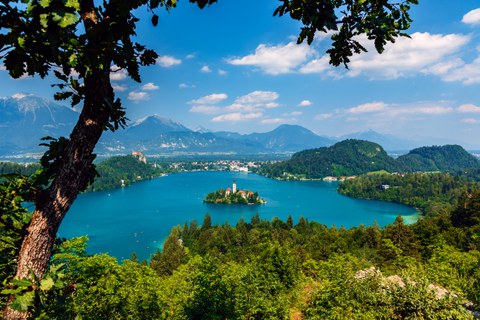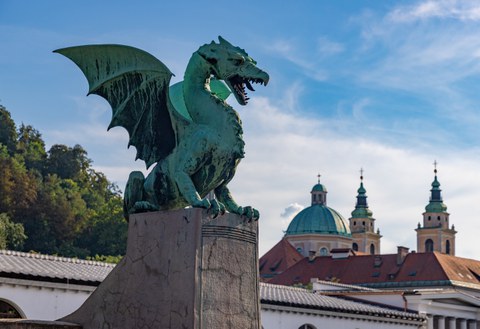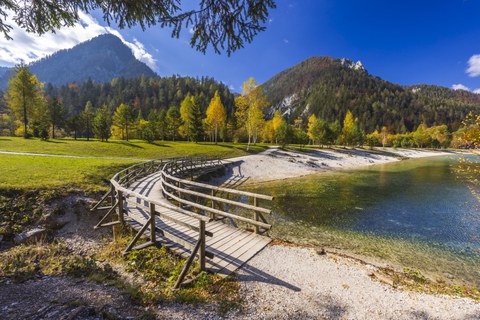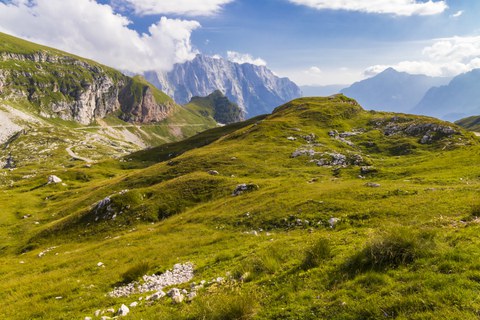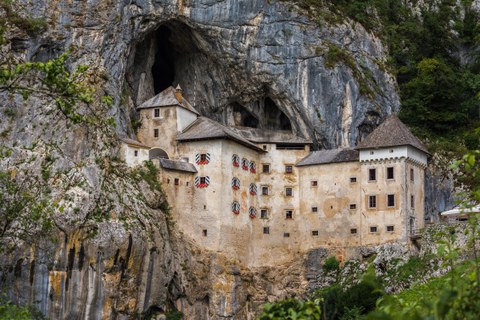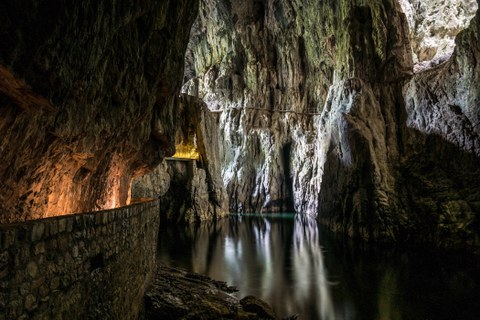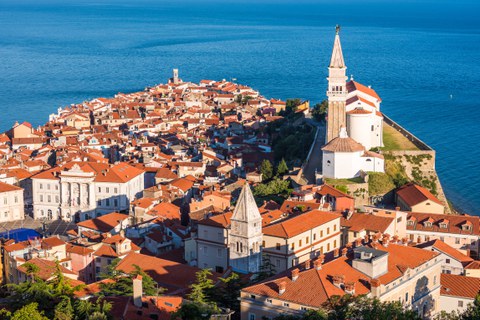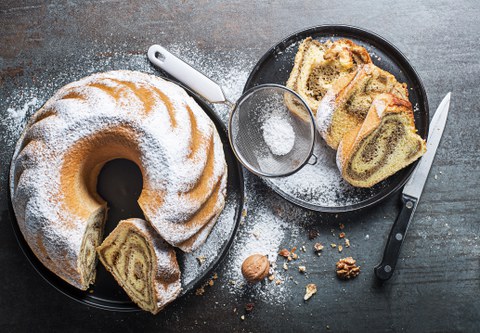Partnerland des Monats Juni 2023: Slowenien
Slowenien, nicht zu verwechseln mit der Slowakei, liegt südlich von Österreich zwischen Italien und Kroatien. Das kleine Land ist eine wahre Naturschönheit. Vom alpinen Norden mit seinen klaren Bergseen über die von tausenden Höhlen durchlöcherte Karstlandschaft bis zu wilden Flüssen, die sich exzellent für Wildwasserrafting eignen – Abenteuer in der Natur findet man in Slowenien sicherlich. Und in unserer Partnerstadt Ljubljana kann man sogar Drachen treffen … oder in der gemütlichen Cafémeile am Fluss entspannen.
Mit der Aktion "Partnerland des Monats" richten wir den Scheinwerfer auf die große Vielfalt der Länder, Regionen und Partneruniversitäten der TU Dresden, in denen unsere Studierenden ein Auslandssemester verbringen können.
Inhaltsverzeichnis
Allgemeine Zahlen und Fakten zu Slowenien
Hauptstadt: Ljubljana
Einwohner: 2,1 Millionen (2022)
Amtssprache: Slowenisch, regional auch Italienisch und Ungarisch
Nationalfeiertag: 25. Juni – Tag der Unabhängigkeit von Jugoslawien
Währung: Euro
Weitere Zahlen, Fakten und Infos findest du auf Wikipedia, bei den DAAD-Länderinformationen oder z.B. bei slovenia.info.
Kleiner Sprachexkurs
- Guten Tag - Dober dan
- Hallo - Živijo
- Wie heißt du? - Kako ti je ime?
- Bis später - Se vidimo
- Entschuldigung - Oprosti
- Können Sie mir helfen? - Mi lahko pomagate?
- Danke - Hvala
Slowenisch (Slovenščina) gehört zu den südslawischen Sprachen und ist am engsten mit dem Kroatischen und dem Serbischen verwandt. Aus dem Tschechischen wurden zusätzliche Buchstaben ins slowenische Alphabet übernommen: č (tsch), š (sch) und ž (weiches sch, wie ein französisches j). Fremdwörter werden slowenisch geschrieben, so wird z.B. manager zu menedžer.
Eine Besonderheit des Slowenischen ist, dass die Grammatik nicht nur Einzahl und Mehrzahl kennt, sondern auch Zweizahl. Mit dem Dual kann man z.B. leicht unterscheiden, ob "wir beide" oder "wir alle" gemeint sind.
Historisch gesehen war Deutsch in Slowenien einflussreich, da das Land lange Zeit vom Heiligen Römischen Reich und später von Österreich-Ungarn beherrscht wurde. Dadurch gibt es in vielen Dialekten noch deutschstämmige Wörter, während die Standardsprache slawischstämmige Wörter bevorzugt. Deutsch ist aber eine häufige zweite Fremdsprache - nach Englisch natürlich, das vor allem junge Slowen:innen in der Regel gut beherrschen.
Um an unserer Partnerhochschule in Ljubljana zu studieren, sind Englischkenntnisse ausreichend. Schau bitte, welches Englisch-Level gefordert wird, bevor du dich bewirbst. Bei TUDIAS kannst du dein Englisch auf jeden Fall aufpolieren, z.B. im Kurs zur Vorbereitung von Auslandsaufenthalten.
Slowenisch lernen ist aber sicher hilfreich beim Knüpfen von Kontakten und Kennenlernen der Kultur. Einen kostenlosen Online-Slowenischkurs findest du auf slonline.si. Dieser wurde vom Institut für Slowenistik unser Partneruni mitentwickelt, das auch Sprachkurse vor Ort anbietet, u.A. einen Intensivkurs für Austauschstudierende.
Wusstest Du schon, dass ....?
- in Ljubljana die Sommerhitze durch selbstgemachten Regen gelindert wird? Im „Areal mit Ljubljanas eigenem Wetter“ sorgen von Künstler Zmago Modic versteckt installierte Wassersprenger jeden Sommer für Abkühlung.
- man früher glaubte, dass in Slowenien Drachen leben, versteckt in den zahlreichen Höhlen, die die Karstlandschaft im Südosten des Landes durchlöchern? Im Winter kann aus Spalten im Fels Drachenatem austreten (Dunst, der durch die höhere Temperatur im Höhleninneren entsteht). Bei Flut herausgespülte kleine rosa Drachenbabys dienten als Hinweis auf das größere Elterntier in den Tiefen der Höhle. Die vermeintlichen Babydrachen sind in Wahrheit Grottenolme, eine Amphibienart im permanenten Larvenstadium, die durch ihre extreme Langlebigkeit beeindruckt. Auch wenn an der Legende dann doch nicht so viel dran ist – zumindest als Symbole sind Drachen in Slowenien allgegenwärtig.
- es in Slowenien Automaten für frische Milch gibt? Die sogenannten Mlekomaten (mleko = Milch) stehen im ganzen Land verteilt, oft auf Plätzen im Ortszentrum. Sie werden direkt von lokalen Milchbauernhöfen betrieben. Neben unbehandelter Rohmilch aus dem Zapfhahn sind an den Mlekomaten auch Milchprodukte wie Joghurt und Frischkäse erhältlich.
- die bisher erfolgreichste slowenische Fernsehserie sich um zwei Liebende aus verfeindeten Weinbau-Dynastien dreht? Dass bei „Usodno Vino“ (Tödlicher Wein) Romeo und Julia in ein Winzerumfeld versetzt wurden, macht Sinn – der Weinbau ist ein wichtiger slowenischer Wirtschaftszweig mit ca. 28.000 Weingütern und zahlreichen Beschäftigten.
-
Käse das Symbol der Liebe für die Hirten der slowenischen Alpen war? Über den Sommer blieben sie bei ihren Tieren oben auf der Alm, und wer sich nach einer Liebsten im Tal sehnte, brachte ihr im Herbst den besonderen Käse Trnič mit. Dieser wurde mit hineingedrückten Mustern dekoriert und immer in Paaren hergestellt. Wenn die Auserwählte ihren Käse annahm, bedeutete das, dass sie die Gefühle erwiderte.
-
Slowenien eine der größten Bärenpopulationen Europas hat? In dem kleinen Land leben über 1.000 Braunbären, die meisten davon in den weitläufigen, naturbelassenen Wäldern von Kočevsko im Süden des Landes. Auch Wölfe und Luchse sowie zahlreiche andere Arten finden hier einen Lebensraum. Wenn die Bären nicht in die Enge getrieben werden, sind Angriffe auf Menschen nicht zu befürchten.
Kooperationen mit der TU Dresden
Eine Übersicht über alle Kooperationen der TU Dresden gibt es in unserer Datenbank. Dort kannst du auch in den Erfahrungsberichten bisheriger Austauschstudierender stöbern. Es lohnt sich außerdem oft, in der eigenen Fakultät Professor:innen zu fragen, die direkte Kontakte zur gewünschten Partneruni haben.
Unsere Kooperationen mit slowenischen Universitäten laufen über Erasmus+. Die Ansprechpartner:innen und Bewerbungsfristen für deine Fakultät findest du hier.
Unsere slowenische Partneruniversität mit Erasmus+: Univerza v Ljubljani
- Studiengänge
- Landschaftsarchitektur
- Forstwissenschaften
- Maschinenwesen (Fakultät)
- Geowissenschaften
- Internationale Beziehungen
- Soziologie
- Chemie und Lebensmittelchemie
- Chemie
- Informatik
- Physik
- Wirtschaftswissenschaften
- Mathematik
- Psychologie
- Sozialpädagogik, Sozialarbeit und Wohlfahrtwissenschaften
- Medizin
- Architektur
- Zahnmedizin
- Die Universität von Ljubljana gilt als älteste und beste Universität Sloweniens. Mit ca. 40.000 Studierenden bewegt sie sich auf einer ähnlichen Größenordnung wie die TU Dresden. Mehr hilfreiche Informationen findest du in diesem Guide für Austauschstudierende.
Don't miss...
Kurentovanje Pust. Im Februar verwandelt sich die Stadt Ptuj zum Treffpunkt von Ungeheuern. Die haarigen, gehörnten Kurenti vertreiben den Winter, indem sie durch die Straßen springen und tanzen und dabei möglichst viel Krach mit ihren Kuhglocken veranstalten. Neben dem Bestaunen der Kostüme kann man hier reichlich Pfannkuchen essen, handgemachten Schnaps probieren und natürlich mittanzen. Das Fest mit uralter Tradition ist eines der größten kulturellen Ereignisse Sloweniens – also such dir rechtzeitig vorher eine Unterkunft.
die Julischen Alpen. Sloweniens Anteil an den Alpen ist ein wunderbares Wandergebiet und liegt fast vollständig im Triglav-Nationalpark, benannt nach dem höchsten Berg des Landes. Am östlichen Rand befindet sich Sloweniens wohl meistfotografierter Ort, der Bleder See. In dessen Nähe lohnt eine Wanderung durch die türkisblaue Vintgarklamm. Besonders schön sind auch die Gegend um den Bohinj-See und das Trenta-Tal, in dem der wilde Fluss Soča entspringt.
Predjamski Grad und Postojna. Die Burg von Predjama ragt halb aus einer Höhle im Berg und galt früher als uneinnehmbar. Laut Legende konnte der ansässige Raubritter nur durch Verrat besiegt werden, als er gerade im Toilettenhäuschen saß - welches dann prompt zum Kanonenziel wurde. Bei Belagerung konnte die Burg über eine Verbindung zum Höhlensystem von Postojna mit Vorräten versorgt werden. Diese Tropfsteinhöhlen zählen zu den schönsten, größten und biologisch vielfältigsten der Welt. Burg und Höhlen können mit einem Gesamtticket besichtigt werden.
In Škocjan formte der Fluss Reka einen unterirdischen Canyon, der direkt aus Mittelerde stammen könnte (inklusive einer kleinen Brücke über den Abgrund - hier zum Glück mit Geländer). Außerdem gibt es Sinterterrassen und Becken, Tropfsteingebilde und sogar unterirdische Wasserfälle zu entdecken. Die Höhlen sind über eine kurze Wanderung vom Städtchen Divača aus erreichbar und können in einer 90-minütigen Tour besichtigt werden.
Das Küstenstädtchen Piran reizt mit mediterranem Flair und verwinkelten Gassen. Vom 13. bis 18. Jahrhundert gehörte Piran zur Republik Venedig, was sich deutlich in der Architektur widerspiegelt (aber nicht in den Touristenmengen). Mehr über die maritime Geschichte der Stadt kann man im Seefahrtsmuseum erfahren. Außerdem lohnt es sich, den nahen Landschaftspark Strunjan mit seiner malerischen Steilküste und den Salinen zu erkunden, in denen noch heute auf traditionelle Weise Salz gewonnen wird.
Lasst uns kochen...
Die Küche Sloweniens unterscheidet sich je nach Region, mit Ähnlichkeiten zu den Nachbarländern Österreich, Italien, Ungarn und Kroatien. Im alpinen Norden werden viel Käse und Milchprodukte, Mehlspeisen, Honig und Wurst gegessen. An der Mittelmeerküste gibt es Fisch, Olivenöl, Schinken und Wein. Für den Osten ist Kürbiskernöl typisch und wird vielseitig verwendet - sogar in Desserts. Ljubljana hat als Hauptstadt eine vielfältige und internationale Küche. Eine unerwartete Ähnlichkeit zu Deutschland: Döner Kebab ist auch in Slowenien ein sehr beliebtes Fastfood.
Sich auf Pflanzenbasis zu ernähren, könnte in typisch slowenischen Restaurants schwierig werden. Aber die tollen örtlichen Gemüsemärkte laden zum Selberkochen ein. Auf dem Land findet man sogar oft Boxen mit frischem Gartengemüse zum Verkauf am Wegesrand.
Potica mit Walnuss- oder Haselnussfüllung
Der köstliche Hefestrudel Potica ist in Slowenien die Nummer eins des Festtagsgebäcks und darf weder zu Ostern, zu Weihnachten noch zu anderen wichtigen Anlässen fehlen. Zubereitet wird Potica aus gerolltem Teig mit verschiedensten Füllungen - mehr als 80 süße oder herzhafte Varianten sind offiziell bekannt. Hier stellen wir die besonders typische Walnussfüllung vor. Auch Haselnüsse, Estragon, Mohn oder Quark sind klassische Füllungen. Wer nirgends gemahlene Walnüsse findet und keinen Mixer besitzt, kann also einfach Haselnüsse verwenden. Gebacken wird Potica traditionell in einer Art Guglhupfform, aber es geht genauso gut in einer Kastenform oder einfach direkt im Ofen.
Achtung: Da der Teig mehrmals gehen muss, braucht das Rezept viel Zeit. Wenn du dafür eher nicht die Geduld hast, musst du dich wohl vor Ort in Slowenien durchprobieren ;)
Zutaten
Für den Teig:
- 1 kg Mehl
- 30 g Hefe
- 3 Eigelbe
- 300 ml lauwarme Milch
- 120 g Butter, geschmolzen
- 1 Teelöffel Salz
- 2 Esslöffel Zucker
- Fett für die Backform
Für die Füllung:
- 700 g Walnüsse oder Haselnüsse, gemahlen oder feingehackt
- 200 g flüssigen Honig
- 50 g Zucker
- 100 ml Milch
- 1 Ei
- Zimt nach Geschmack
- etwas Rum(aroma)
Zubereitung
Teig:
1. Das Mehl in eine Schüssel geben und das Salz damit vermengen.
2. In einer separaten Schüssel die Hefe mit einem TL Zucker, zwei EL Mehl und 50 ml lauwarmen Wassers oder Milch vermischen und an einem warmen Ort ca. 10 min aufgehen lassen.
3. Die drei Eigelbe, Hefemischung, geschmolzene Butter und Zucker zum Mehl hinzugeben. Das Ganze verrühren und dabei nach und nach die lauwarme Milch unterrühren. Den Teig rühren, bis er sich von der Schüssel löst.
4. Mit etwas Mehl bestreuen und mit einem Küchentuch abdecken. Den Teig an einem warmen Ort aufgehen lassen, bis er ungefähr doppelt so groß geworden ist (ca. 1 h).
Füllung:
1. Die Milch auf kleiner Flamme erhitzen, dabei häufig umrühren. Den Zucker zur Milch hinzugeben. Wenn die Milch kochend heiß ist, wird sie über die zerkleinerten Walnüsse gegossen. Honig und Zimt untermischen.
2. Die Füllung abkühlen lassen, dann ein Ei hinzugeben und unterrühren.
Kombination:
1. Den Teig auf einen halben Zentimeter Dicke ausrollen. Mit der Füllung bestreichen und dann fest aufrollen. Wenn eine Backform benutzt wird: Backform einfetten und die Teigrolle in die Backform legen.
2. Die Potica in der Backform noch für eine weitere Stunde aufgehen lassen.
3. Bei 160°C für eine Stunde im Ofen backen. Danach die Potica noch 15 Minuten abkühlen lassen, bevor sie aus der Backform genommen wird. Dober tek!
(Vielen Dank an slovenia.info!)
Kontakt und weitere Ansprechpersonen
Hattest du eine tolle Zeit in Slowenien? Hast du Tipps für Orte und Erlebnisse, die man nicht missen sollte? Gern teilen wir auch deine Erfahrungen – hier, über Social Media oder auch, wenn du Lust hast, bei Infoveranstaltungen mit anderen TUD-Studierenden. Melde dich bei uns:
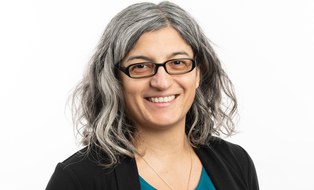 © Sven Ellger/TUD
© Sven Ellger/TUD
Beratung zum Studium im Ausland
NameFrau Federica Serra
Infocenter / TUD weltweit: Amerika, Australien und UK / PROMOS
Eine verschlüsselte E-Mail über das SecureMail-Portal versenden (nur für TUD-externe Personen).
Besuchsadresse:
Fritz Foerster Bau, Büro 156 Mommsenstraße 6
01069 Dresden
Postadresse:
Technische Universität Dresden International Office
01062 Dresden
Sprechzeiten:
- Dienstag:
- 09:30 - 11:30
- 12:30 - 14:30
- Donnerstag:
- 09:30 - 11:30
Bitte im SCS (FOE UG) anmelden.
Partnerländer Archiv
Hast du ein Partnerland verpasst? Kein Problem! Hier sammeln wir alle Seiten für dich zum Nachlesen.
|
Europa (Erasmus+) |
|
|
Afrika |
|
|
Amerika |
|
|
Asien |
|
|
Australien und Ozeanien |
|

